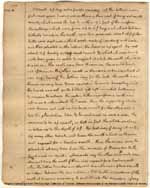A trench 41 deep and 4. f. wide was dug. at the bottom were put small green bushes, and on them a thin coat of dung and earth mixed, which raised the bed to within 2 1/2 feet of the surface. the cuttings which were from 3 1/2 to 6. f. long, and which had been hitherto buried in the earth, were then produced, about 18. 1. of their butts were dipt into a thick paste made of cowdung and water and then planted in the bottom, the Raisins 3. f. apart, the rest about 21 having a stick stuck by each to which it was bound with bear grass in order to support it while the earth should be drawn in. The earth was then thrown in, the mould first, and afterwards the other earth in the same order in which it was dug, leaving the bottom clay for the last. the earth was thrown in very loose & care was taken to avoid trampling in it. the trench was not quite filled, but left somewhat hollowing to receive & retain the water, & the superfluous earth was left on each side without the trench. then the supporting sticks were drawn out and would have served for the other rows had the plantation been to be continued. in such a case, the rows are to be 4 f. apart, so that in fact the whole surface is taken up to the depth of 41 the best way of doing it is to dig every other trench, and leave the earth which is thrown out exposed for a twelve month. then the vines may be planted at any time from the middle of November to the first week in April. afterwards dig the other alternate trenches, and leave the earth of these also exposed for a twelvemonth. when the latter trenches are planted, leave the superflous earth in ridges between the rows of vines till by the subsidence of the earth it becomes necessary to pull it into the trenches. if any

